
- •Preface
- •Contents
- •List of Contributors
- •1. Introduction
- •1. CONSUMER LAW: THE GROWTH OF THE LEGISLATIVE ACQUIS
- •2. EC ADVERTISING LAW
- •4. NEW RULES AND NEW TECHNIQUES—AND NEW CHALLENGES
- •2. The Unfair Commercial Practices Directive and its General Prohibition
- •1. INTRODUCTION
- •2. THE SCOPE (ARTICLE 3)
- •3. INTERNAL MARKET (ARTICLE 4)
- •4. THE STRUCTURE
- •5. THE GENERAL PROHIBITION (ARTICLE 5)
- •7. ENFORCEMENT
- •8. CONCLUSIONS
- •1. SOME BASIC FEATURES
- •2. REDUCED OR RAISED LEVEL OF CONSUMER PROTECTION?
- •5. WILL FULL HARMONISATION BE ACHIEVED?
- •1. INTRODUCTION
- •3. THE FRAGMENTATION OF COMMUNITY RULES ON COMMERCIAL PRACTICES PRIOR TO THE UCPD
- •5. THE IMPACT OF ENLARGEMENT
- •6. DISENTANGLING THE LOGIC OF COMMUNITY INFLUENCE
- •7. THE UCPD AND ITS PROSPECTIVE EFFECTS ON CEE UNFAIR COMMERCIAL PRACTICES LAW: COHERENCE AT LAST?
- •1. INTRODUCTION
- •2. LEGAL BASIS
- •3. GENERAL CHARACTER OF EC CONSUMER PROTECTION RULES
- •5. FUTURE APPROACH OF THE COURT OF JUSTICE
- •6. CONCLUSION
- •1. INTRODUCTION
- •2. SOME CRITICISMS
- •3. POLICY DEBATES ON MAXIMAL HARMONISATION
- •4. THE INTERNAL MARKET CLAUSE
- •5. CONCLUSION
- •1. INTRODUCTION
- •2. THE VISION OF THE CONSUMER IN EC LAW—CONSTITUTIONAL INHIBITIONS TO THE DISCOVERY OF REGULATORY COHERENCE
- •5. THE ‘AVERAGE CONSUMER’ UNDER THE UCPD
- •6. CONCLUSION
- •8. The Relationship of the Unfair Commercial Practices Directive to European and National Contract Laws
- •1. INTRODUCTION
- •3. POSSIBLE INFLUENCES OF THE UCPD ON ‘CONTRACT LAW’
- •5. CONCLUSION
- •9. The Unfair Commercial Practices Directive and its Consequences for the Regulation of Sales Promotion and the Law of Unfair Competition
- •1. INTRODUCTION
- •2. THE DIRECTIVE IN CONTEXT
- •3. THE CASE LAW OF THE COURT OF JUSTICE ON FREE MOVEMENT IN THE AREA OF COMMERCIAL PRACTICES
- •4. THE UNFAIR COMMERCIAL PRACTICES DIRECTIVE: B2C ONLY
- •5. THE LAW OF UNFAIR COMPETITION IN THE MEMBER STATES
- •6. NATIONAL RULES ON SALES PROMOTIONS AFTER THE UCPD
- •7. THE INFLUENCE OF ANTITRUST LAW ON THE LAW OF CONSUMER PROTECTION AND UNFAIR COMPETITION
- •8. PLEA FOR AN INTEGRATED APPROACH AT THE EC LEVEL
- •4. THE EXAMPLE OF LOOK-ALIKES
- •5. SUMMARY AND CONCLUSIONS
- •11. Unfair Commercial Practices: Stamping out Misleading Packaging
- •1. INTRODUCTION—THE THESIS OF THIS PAPER
- •3. THE COPYCAT PROBLEM
- •4. THE IMPACT ON CONSUMERS OF COPYCAT PRODUCTS
- •5. THE UNFAIR COMMERCIAL PRACTICES DIRECTIVE
- •7. THE INTERPLAY BETWEEN PUBLIC AND PRIVATE ENFORCEMENT UNDER THE DIRECTIVE
- •1. INTRODUCTION
- •3. IMPLEMENTING THE UCPD—MAIN CHALLENGES
- •4. AFFECTED LEGISLATION
- •5. TOWARDS IMPLEMENTING THE UCPD INTO UK LAW
- •6. POST-IMPLEMENTATION ISSUES
- •7. STEPS TAKEN TOWARDS IMPLEMENTATION BY THE UK
- •8. CONCLUSIONS
- •2. THE STORY BEGINS—DISTANT SHOPPING (SWEEPSTAKES I)
- •4. REGULATION 2006/2004—NATIONALISATION (VERSTAATLICHUNG) OF LAW ENFORCEMENT
- •Appendix
- •Index
Stamping out Misleading Packaging 197
willingness to find unfairness/misleadingness based on pack-for-pack comparison rather than an unnecessarily high degree of pack similarity.
Practical difficulty in generating evidence of actual misleadingness of the prod- ucts—competitors are forced to conduct surveys/witness interviews, which may then be challenged on the ground that the interviewees are being ‘led’ in providing the evidence.
Thus, consumers in many parts of the EU are better protected from misleading copycats than they are in the UK. The Directive is seeking to ensure a consistent level of protection throughout the EU and to overcome these discrepancies.
Similarly, members’ experience has been that there is more effective protection against misleading copycats in Australia, which has what some consider a statutory form of unfair competition legislation under section 52 of the Trade Practices Act. More detailed analysis of the different laws in several of the larger Member States and in Australia, as applied to copycats, is in Annex 2.
The relatively limited protection available in the UK through passing off presents particular problems because of a unique combination of features of the UK retail market place. These features include:
High concentration in the retail market, with a small number of powerful retailers;
A particularly sophisticated own label offer by comparison with other European markets;
A large own label share—according to GFK/Worldpanel14 (2005) the UK’s share of own label is the second highest in Europe (after Switzerland) at 39.9 per cent.
7. THE INTERPLAY BETWEEN PUBLIC AND PRIVATE ENFORCEMENT UNDER THE DIRECTIVE
In the United Kingdom at present, it is only brand owners who in practice exercise any right of recourse against copycat products, and their rights are generally limited to the right to bring an action in tort for passing-off, the limitations of which have already been described. In a minority of cases the brand owner may be able to bring an action for trade mark or other intellectual property infringement. However, most copycat products are so designed that they do not usually infringe registered rights but use subtler means to mimic the attributes of branded products.
14 Gfk/Worldpanel, ‘Private Label Trends in Europe’, Planet Retail, June 2006, available at www. competition-law.ox.ac.uk/lawvle/users/ezrachia/CCLP%20S.%2012-06.pdf.
198 Vanessa Marsland
Research indicates that when it comes to enforcement of national fairness laws aimed at protecting consumers in relation to consumer practices the United Kingdom differs from most other Member States by reason of the widespread reliance on self-regulatory codes.15 The absence of a relevant self-regulatory code dealing with copycats and the practical absence of public enforcement means that, in order to fulfil the objective of the UCPD,
15 June 2003 report “Analysis of National Fairness Laws Aimed at Protecting Consumers in Relation to Commercial Practices”, coordinated by Prof Dr Reiner Schulze and Prof Dr Hans Schulte-Nolke, report commissioned by the Directorate-General Health and Consumer Protection of the European Commission (DG SANCO) (June 2003).
‘Nearly all Member States apply a similar set of sanctions against unfair commercial practices (e.g. injunctions, damages, penal sanctions). In practice, the typically used sanctions may differ from the model laid down in the legal framework.
Both aspects—enforcement system and applied sanctions —are of course influenced by the general approach to unfair commercial practices in the Member States.
The Consumer Ombudsman (CO) is the key enforcement institution in the Scandinavian countries. The independent position as a public watchdog on marketing practices seems to be one of the reasons for the success of this institution which is held in high reputation in the Scandinavian countries. Although the CO can initiate legal proceedings against unfair commercial practices, many cases can already be settled through measures taken by the CO.
A different approach is taken by countries like Austria, Belgium, Germany and Spain. In these countries legal actions against unfair commercial practices are taken by competitors or by associations of competitors or consumers. Interestingly, in countries such as Austria and Germany rules protecting consumers and those protecting competitors can both be enforced by competitors’ associations. A clear delimitation in this field can be found in Belgium. Under Belgian law business associations can only bring an action against unfair practices violating Art. 93 LPC whereas consumer associations can only initiate proceedings against practices violating Art. 94 LPC.
Only in a few countries (e.g. Austria and France) can single consumers initiate legal proceedings against unfair commercial practices. Probably due to financial risks, consumers do not use this possibility very often.
The role of public authorities applying penal sanctions, especially fines, varies between the Member States. Due to the legal framework in this field, French authorities play a rather important role—several examples were outlined above—whereas in other Member States public authorities play a minor role. In this context the nulla poena sine lege principle sets strict limits to the application of penal sanctions for the violation of fairness rules, especially in cases where the commercial fairness provisions are formulated in a rather general way.
A completely different approach can be found in the United Kingdom. Due to widespread self-regulation in the field of unfair commercial practices many sanctions also derive from self-regulatory codes. Theoretically consumers and competitors can bring legal actions against unfair practices under common law or some statues in this field. In practice most of the cases can be settled through self-regulatory mechanisms, e.g. decisions of the Advertising Standards Authority leading to adverse publicity. The self-regulatory system is encouraged and guided by the Office of Fair Trading (OFT). In severe cases exhausting self-regulatory mechanisms the OFT can initiate legal proceedings against businesses using unfair practices.
As mentioned above, often a similar set of sanctions applies to unfair commercial practices. In all Member States an injunction or cease and desist order can be obtained, which is probably the most effective sanction as it stops the unfair behaviour. According to the Directive on injunctions for the protection of consumer’s interests, registered consumer associations are entitled to obtain an injunction against misleading advertising. This Directive has been transposed in all Member States.
Additionally, in some Member States a court may order that the effects of unfair practices have to be removed (e.g. correction of misleading information) and that the judgment may be published.
Stamping out Misleading Packaging 199
it will be necessary to give both consumers and competitors enhanced enforcement rights.
The Directive requires that ‘persons or organisations . . . having a legitimate interest in the matter must have legal remedies for initiating proceedings against unfair commercial practices’.16 The DTI has suggested that enabling consumers to make complaints to the appropriate administrative authority will be adequate to satisfy the obligation in Article 11.1.
However, as explained above, it is unlikely that complaints will be made or that Trading Standards Offices (TSOs) will treat copycat cases as priority cases for their limited resources. Therefore, in order to enforce compliance with the provisions of this UCPD in the interests of consumers, as provided for in Article 11.1 of the Directive, it will be necessary to extend enforcement rights to competitors.
It is also suggested by the DTI that the UK will comply with the UCPD if competitors are given the right to bring complaints before the TSOs (assuming they are the relevant administrative authority). However, based on the experience under the Trade Descriptions Act 1968, and from an understanding of Trading Standards’ priorities and resources, it is unlikely that TSOs will devote resources to pursuing individual cases of copycats. Therefore, in order for consumers to be protected as required by the UCPD, it will be necessary for brand owners to take action against copycats directly relying on the UCPD provisions as implemented in English law.
Accordingly, in order to comply with the UCPD it will be necessary for the UK implementing legislation to give competitors the explicit right to bring an action in respect of copycat products under the UCPD. If that right were not to be granted the enforcement means referred to in Article 11.1 would be of no effect.
This will mean that in future a brand owner will have the option of bringing parallel actions, one for passing-off and the other for breach of the UCPD (in a similar manner to the situation in Australia, in respect of section 52 of the Trade Practices Act).
Empowering competitors to act in respect of all forms of unfair or misleading commercial practices covered by the Directive could risk cutting across existing effective mechanisms, such as self-regulatory regimes, and some types of practice are inherently unsuited to enforcement by a competitor. However, the copycat issue is a very specific example of misleadingness where the interests of consumers and competitors are the same, where there
In many countries, competitors and consumers are entitled to damages. Especially in cases harming consumers this may not be the most appropriate sanction as they often only suffer a small financial loss and may not find it attractive to start court proceedings.
Generally speaking, in all Member States severe cases of unfair commercial practices face severe penal sanctions such as fines or even imprisonment. A special fine can be found in Sweden, the so-called market disruption fee’. (ibid, at 82 and 83)
16 See Recital 21, above n emphasis added.
200 Vanessa Marsland
is no effective self-regulatory mechanism, and where effective protection for consumers is most likely to be provided by enabling competitors to bring civil actions to prevent misleading practices.
ANNEX 1—AN ANALYSIS OF REMEDIES IN THE UK
Trade Mark Legislation
Registered trade marks are not designed to address copycat packaging and are ineffective in doing so. As Patrick McLoughlin MP stated in the House of Commons at the time of the Trade Marks Bill (1994),17 ‘the main characteristic of a look-alike product is that it does not copy a trade mark’.
Typically a copycat borrows a small amount from each of several aspects of the original product. It may reproduce part of the surface decoration, part of the shape, part of the colour and part of the brand name without reproducing any of these elements completely. In doing so, the copycat avoids infringing any single intellectual property right, but captures sufficient of the look and feel of the original to mislead shoppers. It therefore is able to avoid any trade mark infringement.
Trade marks are valuable of course in protecting against the use by a competitor of identical marks on identical goods, but many packaging features are simply not capable of registration if they are not deemed sufficiently distinctive. It would therefore be impossible (let alone enormously expensive) to register the full range of packaging features that might be used by a copycat.
To bring an infringement case against similar marks being used on identical or similar goods, it is necessary to prove likelihood of consumer confusion. In the case of copycats, similar marks are not often used and, even if they are, on a ‘global appreciation’ (the test set by the European Court of
Justice in cases such as Sabel v Puma 18) confusion may not arise.
A further limitation concerns the thorough registration process, which takes an impractical length of time in the context of fighting copycats. Where acquired distinctiveness has to be proved, typically three to five years’ sales are required by the Registry, whilst a copycat can be (and often is) launched in a few months and could itself reduce the distinctiveness of the original.
The limitations of trade marks in fighting copycats are illustrated by the Penguin v Puffin19 case in 1997. The survey evidence that sought to show consumer confusion was dismissed and the judge found no case of trade mark infringement, recognising that Puffins and Penguins are very different birds, being, literally, poles apart.
17Hc Debs, vol 000, col 299 (16 May 1994).
18Case C–251/95 [1997] ECR I–6191.
19ChD, 18 Mar 1997 not reported.
Stamping out Misleading Packaging 201
Registered Designs
Registered designs (both UK and Community) provide strong protection against counterfeits and provide a valuable means of protecting the shape of a product’s packaging. Design registrations protect against substantial reproduction of a design, which in the context of packaging is defined as the shape, configuration, pattern or ornament applied to an article.
As a means of tackling copycats, however, registered designs have their shortcomings. The whole of the copy must not be substantially different from the whole of the registered design and an infringer must produce an article ‘not substantially different’ in order for a legal challenge to be successful. While copycats tend to borrow the essence of the original design, they tend not to use aspects which are subject to a registration or not to use substantial reproduction of these aspects. Furthermore, the rights cover the surface pattern but excludes ‘printed matter primarily of . . . .artistic character, including . . .. Trade advertisements and similar articles’.
A registration-based system, as in the case of trade marks, has shortcomings in tackling copycats. These include the necessary time required to register, the difficulty in ascertaining what to register and the cost of registration (particularly of multiple registrations). Product packaging of fast-moving consumer goods (fmcg) changes frequently, compounding these shortcomings. Indeed, as designs must be new to be registrable, it is unlikely that later iterations of a pack’s design will be eligible for this protection.
Unregistered Designs (Design Right)
Unregistered design protection has an advantage over registered designs in that it is an automatic right. However, protection is afforded only to the shape or configuration of a pack, not to its surface decoration (which would be covered by copyright). While substantial reproduction of any aspect of a design constitutes infringement, recent decisions suggest that the whole of an article must be considered, even if only a part has been copied.
A significant shortcoming in the context of copycats is the need to show copying. This is defined narrowly by the courts and tends to be avoided by the producers of copycats.
Copyright
While copyright has the advantage of being an automatic right rather than a registration-based system and protects the surface decoration of products, it provides no protection against those that copy the shape of articles. It is also necessary to show that the copying has been ‘substantial’, something
202 Vanessa Marsland
that copycats avoid when designing surface decoration. Also in relation to copyright in pack designs, it is often difficult to track down the original author of the copyright work.
While unregistered designs protect the shape of the pack and copyright its surface decoration, these are independent rights, and the courts therefore do not look at them together. Instead, the court will consider whether the shape of a pack has been substantially reproduced and will then consider, separately, whether the surface decoration has been substantially reproduced. A copycat can clear both these tests individually while still achieving the look and feel of the original product.
Passing–Off
As the common law of passing-off is intended to prevent traders passing off themselves or their goods as those of another trader, to the extent that it causes that other trader damage, it could be deemed to be well suited to addressing copycats. However it has some significant disadvantages:
—obtaining factual evidence that consumers are being misled is very difficult. As copycats tend to be low value goods, consumers rarely complain. Some will blame themselves for their error or put it down to experience, while others will remain unaware that their assumptions about a product, induced by its packaging, are wrong. Furthermore, it is not practical to research in-store whether consumers are being misled as this would not be allowed by the retailer selling the copycat;
—proving that there is a risk of consumers being misled using evidence such as surveys (eg in the street or in mocked-up shops) is also fraught with difficulty as these must meet the rigorous standards set by UK courts.
—Obtaining interlocutory relief under passing-off is extremely risky and time consuming. It is necessary to show in affidavit evidence that there is an arguable case and evidence of irreparable harm. This is difficult to achieve quickly in the case of copycats. Furthermore, if the decision is reversed at full trial, the elaimant may (rightly) face punitive damages for the defendant’s lost sales.
The Penguin v Puffin20 case referred to above illustrates the potential but also the problems with passing-off. The judge found in favour of Penguin under passing–off and Asda was forced to change the packaging, but this outcome was uncertain and could not have been reasonably predicted (as the survey evidence was withdrawn, the judge relied on the persuasiveness of a few witnesses). Furthermore he did not specify how close to Penguin’s packaging Puffin could go. As a result Puffin biscuits remain on the shelf today.
20 Ibid.
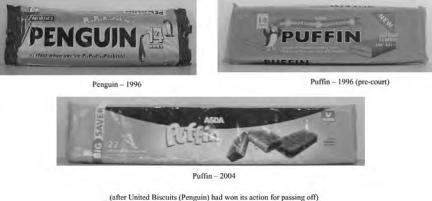
Stamping out Misleading Packaging 203
The Relevant Designs for Penguin
Self Regulation: The CAP21 Code
That the copying and deception of consumers exemplified by copycat packaging are undesirable is recognised and addressed in The British Code of Advertising, Sales Promotion and Direct Marketing,22 administered by the Advertising Standards Authority. Article 20.2, a provision against unfair advantage,23 and Article 21.1, a provision against imitation,24 would under normal circumstances provide some help in addressing copycats. However, while the code covers advertising, sales promotion and direct marketing, it does not cover packaging.
Packaging is arguably the most powerful of marketing tools, exerting its influence at point of sale where around 70 per cent of shoppers’ purchasing decisions are made. However packaging remains outside the scope of the
CAP Code as there is no enforcement mechanism that can be applied by the self-regulatory authority.
The IGD25 Dispute Resolution Procedure
As the name suggests, this is more a dispute resolution procedure than a self-regulatory mechanism although it calls on signatories not to use similar
21Committee of Advertising Practice.
22Available at www.cap.org.uk/cap/codes/cap_code/.
23Marketers should not take unfair advantage of the reputation of trade marks, trade names or other distinguishing marks of organisations or of the designation of origin of competing products.
24No marketing communication should so closely resemble any other that it misleads, is likely to mislead or causes confusion.
25Institute for Grocery Distribution.
204 Vanessa Marsland
features to those of another product.26 Any such procedure is only as strong as its signatories, and relies on the ability of the parties to agree. In this case, while some of the major supermarkets are signatories, most retailers are not, and it is limited to the grocery sector. The procedure is shrouded in secrecy so it is impossible to know how often it has been invoked.
ANNEX 2—LEGAL MEASURES AVAILABLE IN DIFFERENT
COUNTRIES
The Annex provides a brief survey of legal measures apart from intellectual property rights available to competitors in different Member States and in Australia to combat copycat packaging and get-up.
The Netherlands
The Dutch Unfair Competition Doctrine of ‘Slavish Imitations’
Article 6:162 of the Dutch Civil Code provides for protection against unfair competition under the so-called doctrine of ‘slavish imitations’. The protection against unfair competition stands side by side with the protection of registered trade marks and designs.
The Dutch courts have developed the doctrine of ‘slavish imitations’, which applies where a product copies elements of the packaging or get-up of another product so as to cause confusion amongst the public as to the commercial origin of the product or as to a connection of the copycat product with the maker of the original product. Competitors can take action under the relevant section to stop such acts of unfair competition.
Unlike the English passing off action, it is not a requirement under the
‘slavish imitations’ doctrine that the party making the complaint should prove that he acquired goodwill in the packaging being imitated or that the imitation causes damage to its business.
Examples from the Dutch Case Law
(1) In a decision of 6 July 2005, the District Court of Breda upheld a claim by Lego Systems A/S against Mega Bloks Inc27 regarding the imitation of
26‘For the purpose of avoiding or resolving disputes, it is accepted that a product sold in the United Kingdom should avoid using any combination of the same or similar name, colour scheme, shape, typeface, design layout or portrayed images so as to convey significant visual features which are essentially similar to the those of another product. Exceptionally, a single feature may be sufficiently significant’: IGD Dispute Resolution Procedure.
27Lego Systems A/S v Mega Bloks Inc (118470/HA ZA03-501).
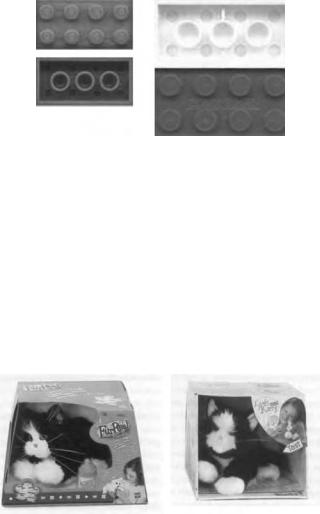
Stamping out Misleading Packaging 205
toy building blocks. Despite the fact that LEGO’S registered intellectual property rights in relation to the building blocks had expired, the court held that it was possible for Mega Bloks to avoid confusion with LEGO blocks without impairing the functionality of the product. Mega Bloks failed to do so and its conduct was held to amount to unfair competition. Images of the Lego bricks and the Mega Bloks imitation bricks in question are provided below:
(2) In a decision of the District Court of Amsterdam of 15 April 2004,28 Hasbro Inc was successful in a claim against Simba Toys GmbH in relation to the imitation of a toy kitten. Images of the original product (sold under the trade mark FUR REAL) and the imitation (sold under the trade mark LOVELY KITTEN) are provided below. The court held that Hasbro could assert no copyright in its product as the product lacked the necessary originality. No registered intellectual property rights were available either. The court held, however, that Simba Toys’ LOVELY KITTEN product slavishly imitated Hasbro’s product and that Simba failed to implement necessary differences in order to prevent the risk of avoidable confusion.
28 Hasbro Inc v Simbra Toys GmbH (IER 2004/62).
206 Vanessa Marsland
Germany
The Provisions of the German Unfair Competition Act (the ‘UWG’) relating to Misleading Trade Practices
In addition to the protection provided under German law to registered intellectual properties such as trade marks and design, the German Trade Marks Act provides protection to unregistered trade marks which have acquired reputation through use. Protection of unregistered trade marks in Germany is largely equivalent to the protection provided in passing-off in the UK where the imitation concerns unregistered marks. In addition, however, a broader scope of protection against unfair commercial practices is available in Germany under the Unfair Competition Act (known as the UWG).
In the area of copycat products, protection can be sought under the UWG under section. 4, No. 9(a), which prohibits acts in commerce which lead to a likelihood of confusion regarding the commercial source of a product. The elements of the claim are that the product or package being copied (ie the original branded product) incorporates competitively significant qualities, characteristics or features, and that the copycat, by imitating those elements, leads to a confusion of origin which would have otherwise been avoidable.
Under section. 8(3), No 1 UWG, a direct competitor can take action for breaches of the provisions of the UWG and may apply to the court for injunctions and orders for the recall of products and the destruction of goods and infringing advertising. Any person injured by unfair acts of competition (including competitors) can claim damages under section. 9 UWG where the offender has acted intentionally or negligently.
Unlike the passing off action in the UK, the claimant under the unfair competition provisions of the UWG does not need to show that he acquired goodwill in the packaging or get-up of the product being copied, and unless such claimant seeks to claim damages it is not necessary to show that the imitation caused damages to the claimant.
Examples from the German Case Law
(1) In a case of 15 September 200529 the German Supreme Court issued an injunction against the sale of copycat jeans on the ground that the stitching patterns, which were copied from the claimant’s product, were likely to cause confusion regarding the origin of the copycat product. The Court ruled that the original product incorporated competitively significant features and that the copycat, having imitated those features, was likely to lead
29 AZ/ZR 161/OZ, (Bech RS).
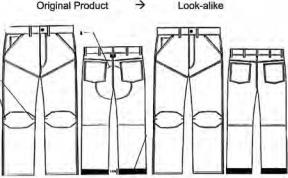
Stamping out Misleading Packaging 207
to avoidable confusion as to origin. The decision was based purely on the unfair competition provisions as the claimant did not allege an infringement of any intellectual property rights.
Representations of the stitching patterns of the original and copycat jeans are provided below:
It is significant that the German Supreme Court rejected the argument raised by the defendant in this case that the unfair competition provisions did not apply on the ground that the stitching patterns enjoyed protection as unregistered designs under the Community Design Regulation.30 The Supreme Court held that the Community Design Regulation did not preclude the application of unfair competition laws, and whereas its purpose was to protect the private work of the person who created the design, the provisions of the UWG were aimed at protecting consumers against misrepresentation.
The decision demonstrates the policy under the German unfair competition law to protect consumer interests by giving a right of action to competitors, on the basis that consumers and competitors alike have a mutual interest in preventing imitations which lead to confusion and deception. This, again, highlights the difference between the unfair competition laws in Germany and the passing off action in the UK, which protects the private interest of the claimant in its goodwill.
(2) On 24 November 2003, the Cologne Regional Court granted an injunction against the sale of OSCAR HUNDE-MENUE dog food cans under sections. 3 and 4, No 9 UWG (misrepresentation of origin)31 on the ground that the product label was too similar to that of the well-known PEDIGREE brand for dog food.
30Council Regulation 6/2002 [2002] OJ.
31Masterfoods GmbH v Plus Warenhandels GmbH 33 0415/03.
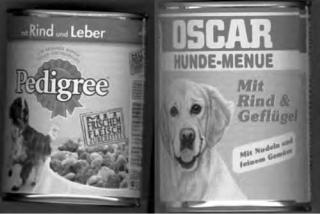
208 Vanessa Marsland
The court held that significant elements of the original product packaging were copied, such as the yellow background and contrasting red border at the top of the label. The court held that these elements were likely to affect a consumer’s perception of the source of the product and therefore their use constituted actionable unfair competition. Pictures of the two product labels are provided below:
Spain
The Provisions of the Spanish Unfair Competition Law relating to Misleading Conduct
Under Spanish law, protection is provided against unfair competition practices in addition to and side by side with the protection of specific intellectual property rights. The Spanish Unfair Competition Act32 can be invoked in cases where there are no registered trade mark or other registered intellectual property rights, or where such rights are not infringed but where, nevertheless, a competitor takes unfair advantage of another trader’s goodwill or reputation, or engages in conduct which might otherwise be considered as unfair.
The Spanish Unfair Competition Act prohibits, among others things:
—practices causing confusion as to the commercial source of goods or services;
—misleading or false indications or omissions as to the nature, characteristics, quality or quantity of the product; and
—imitation likely to cause confusion as to the commercial source of a product in order to take unfair advantage of the reputation or effort of another trader.
32 Act 3/1991 of 10 Jan 1991.
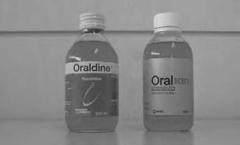
Stamping out Misleading Packaging 209
Under Article 19 of the Spanish Unfair Competition Act, any trader whose economic interests are directly damaged or affected by an unfair act can take action before the Mercantile Court. In addition, consumer groups or associations can take action where the unfair conduct directly relates to their area of interest.
As in the case of Germany and The Netherlands, the unfair competition law in Spain is broader than the action of passing-off in the UK, as it is not a requirement to show that the original packaging or get-up of the product attracted goodwill or that the imitation caused damage to the competitor whose product is being imitated. It is sufficient to show that the imitation is likely to cause customer confusion.
Examples from Spanish Case Law
(1) Warner Lambert Consumer Healthcare,33 which makes the pharmaceutical preparation ORALDINE, was successful in an unfair competition claim against the Spanish company Laboratorios KIN SA which sold a similarly looking product under the name ORALKIN. This was a pure unfair competition case and no claims were brought alleging trade mark infringement or asserting other intellectual property rights. The court held that due to the visual similarities between the products, there was a clear risk that consumers would confuse them or associate the defendant’s product with the claimant’s. The defendant’s product, ORALKIN, like the claimant’s ORALDINE, was sold without a box, in a rounded, transparent 200 ml container of a shape very similar to the claimant’s ORALDINE product; in both cases, the liquid visible inside the bottle was a red-pink colour and the label combined blue, red-pink and white. The risk for consumers was particularly serious as Warner Lambert’s ORALDINE was a medicine designed to treat minor infections of the mouth, whereas the imitation ORALKIN was simply a cosmetic oral hygiene product. Images of the two products are provided below:
33 Warner Lambert Consumer v Laboratorios KINSA (Oraldine/Oraklin), CFI No 4, Barcelona, not reported.
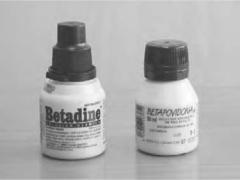
210Vanessa Marsland
(2)Mundipharma AG & Viatris Pharmaceuticals, SA v Laboratorios Betamadrileño, SL34 (BETADINE/BETAPOVIDONA) was another example where a claim of unfair competition was brought in respect of a copycat product. Again, the case involved no claims of infringement of intellectual property rights. The claimants brought the claim on the ground that the presentation of the defendant’s antiseptic solution product BETAPOVIDONA was an imitation of the claimants’ product BETADINE (combining a rounded shaped yellow bottle with a black cap, sold without a box with product information printed in black), encouraged confusion and constituted an act of unfair competition. The court held that the similar presentation of the product was likely to cause confusion and ordered that the defendant cease the manufacture and marketing of the offending product and that it remove the product from the market along with any promotional and advertising material. The defendant was also ordered to publish the decision in two nationally circulated newspapers in Spain. Images of the two products are provided below:
France
The Application of the French Unfair Competition Law to Copycat Packaging
In addition to and side by side with the protection of trade marks under French law, Article 1382 of the French Civil Code provides for protection against unfair competition. The provision applies where the similarity between products or their packaging creates a risk of confusion. For an action to succeed, there must be an imitation of the essential and specific elements of the product that are neither usual nor necessary nor commonly used in respect of such products. Competitors injured by an unfair competition practice can take action in court to stop such a practice.
34 Not reported.

Stamping out Misleading Packaging 211
Again, as in the case of other unfair competition laws, it is not necessary for the trader who brings an action complaining that the defendant copied his product packaging or the appearance of his product to show that he has acquired goodwill in such packaging or get-up, as he would in a passing off action. It is sufficient that the packaging or get-up is not usual, necessary or commonly used.
Examples from the French Case Law
In a decision of 17 March 2004 in an action brought by Danone against Bridel,35 the French Supreme Court found for the claimant in a case concerning the imitation of elements of the packaging. The Court held that ‘the adoption by a competitor of a packaging which recaptures all the distinctive and recognised elements of a product packaging of another undertaking (and not providing the necessary product information to the prospective consumer) constitutes a civil wrong, even where the original packaging is not subject to protection by way of registered rights’. Images of the original Danone product (ACTIMEL) and the copycat (B’A) are provided below:
Italy
The Application of the Italian Unfair Competition Law to ‘Slavish Imitation’
In addition to protecting registered and unregistered trade marks, Italian law provides protection against unfair competition under section 2598, no 1 of the Italian Civil Code, which allows competitors to take action against ‘slavish imitations’ of their products or product packaging. Again, unlike the passing off action, the ‘slavish imitations’ doctrine focuses on protecting the consumer’s interest in preventing imitations that are likely to cause confusion. It does not require a competitor who brings action to show that the packaging or get-up in question acquired goodwill in the market place.
Examples from the Italian Case Law
(1) In a decision of the Court of Naples of 17 July 2003,36 the court found for the claimant in a case concerning a copycat packaging of a perfume
35Danone v Bridel court of cessation commercial chamber, 17 march 2004, No 02-13242 available at www.legifrance.gouvifr/WAspad/UnDocument?base= INCA &nod=1xcxcx2004x 03x04x00132x042.
36Acqua di Parma Srl v Le Gioie Sas di Caiata Clandio and another, No 19918/2001 [2003] Giuris rudenza Napoletana 353.

212 Vanessa Marsland
bottle. The Court of Naples stated in the decision that the likelihood of confusion arising from a ‘slavish imitation’ of the packaging was not excluded by the fact that the two products bore different trade marks. The judge stated that the packaging of the defendant’s product was very similar to that of the claimant’s. The court pointed out that the imitation of the shape of the packaging in itself was not unlawful as the shape was very common. On the other hand, the competitor was using an identical colour on the packaging which was not usual in the relevant market, and thus a very distinctive element of the packaging. This particular case did not turn purely on the packaging as the court also took into consideration that the defendant used a sign which was similar to the trade mark placed on the original packaging.
(2) In a decision of the Court of Verona of 21 September 199237, the court held that the packaging of the SINDRAMED toothpaste was confusingly similar to the packaging of the claimant’s toothpaste CAPITANO amounting to unfair competition under section 2598, No 1 of the Civil Code. Images of the two packages are provided below:
(3) In a decision of the Court of Naples of July 14, 2005,38 the court upheld a claim concerning the imitation of bedlinen packaging. The court stated that the strong similarity between the defendant’s packaging and the claimant’s showed the competitor’s intention to reproduce all the elements of the original product. The court also pointed out that the presence of a different trade mark on the defendant’s packaging did not exclude the likelihood of confusion. The court found similarities between the two products, in that the colour of the packaging was in both cases blue (albeit in different shades); the trade marks of each respective product (although different) were placed on the upper part of the packaging; the front of the packaging featured an open couch-shape through which the product was visible (this element also being crossed by a strip providing product information); the back
37Lu Farmaceutici Dr Ciccarelli SpA v Lidl italia Srl, not reported. For a short comment see [1992] EIPR D–238.
38Frame Srl e Fratelli Ambrosio Srl v New Nagitex Srl No 14712/2005, available at www. ip-italjuris.it.
Stamping out Misleading Packaging 213
of the packaging bore a picture of a yellow sofa; and another picture of a sofa appears on the side of the packaging.
Australia
The Application of Sections 52 and 53 of the Trade Practices Act 1974 to Copycat Products
Insofar as it concerns registered intellectual property rights, copyright and the tort of passing-off, the law in Australia is similar to that of the UK in relation to protection against copycat products. In addition, however, sections 52 and 53 of the Australian Trade Practices Act 1974 (‘TPA’) provide a more general protection against unfair competition and misleading advertising. Section 52 of the TPA provides that ‘a corporation must not, in trade or commerce, engage in conduct that is misleading or deceptive or is likely to mislead or deceive’.
A claim under section 52 of the TPA is not founded on the protection of goodwill or reputation (as is the case in passing-off); the focus rather is on public interest and consumer protection. Section 53 of the TPA prohibits specific forms of false, misleading or deceptive conduct. For example, it prohibits traders from representing that goods have sponsorship or approval which they do not have.
Under the TPA, any person can bring an action against a perpetrator. The conduct creates the jurisdiction, not the status of the complainant. Thus, any person can bring a court action against a company for breaches of sections 52 and 53 of the TPA, including competitors, consumers, consumer groups and a designated public authority, the Australian Competition and Consumer Commission. However, most actions are brought by competitors rather than consumers or the authorities. Further, the designated public authority tends not to pursue complaints brought by competitors, on the basis that they are free to do so independently.
The TPA empowers the Australian courts to issue a wide range of remedies in relation to unfair trade practices including (among others) injunctions, product recalls, orders to destroy offending products or packaging, orders for corrective advertising and awards of damages.
Examples from the Australian Case Law
(1) In Pacific Publications Pty Limited v IPC Media Pty Limited,39 a claim by the publisher of ‘HOME BEAUTIFUL’ magazine against the publication of a rival magazine ‘25 BEAUTIFUL HOMES’ at the Australian
39 (2003) 57 Intellectual Property Reports 28.
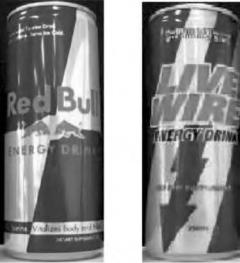
214 Vanessa Marsland
Federal Court was successful under section 52 of the TPA, even though an additional claim for trade mark infringement had failed. Whilst the court found that the magazine title ‘25 BEAUTIFUL HOMES’ was not deceptively similar and therefore did not infringe the trade mark ‘HOME BEAUTIFUL’, it upheld the claim under section 52 of the TPA on the ground that the defendant’s conduct was misleading and deceptive in that it instructed newsagents to place its magazine next to the HOME BEAUTIFUL magazine, using identical photos of homes previously featured in HOME BEAUTIFUL magazine, and not indicating the connection of the 25 BEAUTIFUL HOMES magazine to its UK parent magazine.
(2) In Sydneywide Distributors Pty Limited v Red Bull Australia Pty Limited40 the maker of the Red Bull energy drink was successful both in passing off and in a claim under section 52 of the TPA against an attempt by the defendant company, in the words of the court, to ‘sail as close to the wind’ as possible to take advantage of the market share that Red Bull had acquired through its substantial marketing. The court found that the defendant had intentionally adopted a get-up which appropriated part of the trade or reputation of Red Bull by copying the colour combination and general look of the can. The decision was upheld on appeal. Images of the claimant’s and the defendant’s products are set out below:
40 (2002) 55 Intellectual Property Reports 354.
